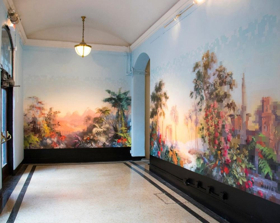Miller Theatre Unveils Lobby Installation By Dominican-American Artist Joiri Minaya

This August, the Dominican-American artist Joiri Minaya transforms the lobby of Miller Theatre with a new installation from her series Tropical Surfaces, in which she specifically deconstructs and re-imagines tropical design, pointing to it as an invention of the Global North's "imaginary."
Joiri Minaya's work focuses on the construction of the female subject in relation to nature and landscape in a "tropical" context, shaped by a foreign gaze that demands leisure and pleasure. Like nature, the feminine has been imagined throughout history as tamed, idealized, and exoticized. Minaya revises existing objects that engage in this form of representation, thus provoking questions.
In her series Tropical Surfaces, Minaya subverts and appropriates gendered consumer products including wallpaper and clothes, as well as tropes of domesticity and decoration. Her critical reclamation of this territory involves a contemporary disruption of tropical pattern design. The roots of such design in botanical illustration also conjures an original use value for such popular depictions, in their promotion of the resources to be found in the colonies.
For Miller Theatre's Redecode II: La Dorada, Minaya departs from a monumental work held by the Cooper Hewitt, El Dorado, a twenty-four panel scenic wallpaper designed in 1848 for the oldest continuously-operating wallpaper company, Zuber et Cie (est. 1787, France). El Dorado depicts the idealized natural and manmade riches of the four continents from a European, and colonial perspective. The transformation of this vision into such an elaborate wallpaper was necessary for the delectation of those who could afford it; its production required the hand-printing of 1,554 distinct woodblocks in 210 various colors over the entire 42-foot-long span.
Zuber's original wallpaper positions Europe at the center of the design, representing it as the only continent with steps in the foreground, which seems to invite the viewer to a terrace overlooking the rest of the world. The other continents' architecture is depicted far in the background, with wild, exquisitely detailed depictions of nature covering their foreground, suggesting an adventurous, exploratory invitation to enter the landscape. Minaya uses pixilation to sabotage these design choices, posing questions of visibility and refusal, while flattening and mixing the planes of foreground and background equally. In addition, Europe has been isolated in its own separate wall on one side of the lobby, while the other continents band together on the other side. Not only does Minaya select and reorganize the continents, but she embeds interactive QR codes in the design, camouflaged among the pixels. They contain links that can be scanned with smartphones, revealing found text, images, and videos from the internet, as well as content uploaded by the artist, carefully curated and specifically placed within the wallpaper as part of the piece's commentary.
"Minaya's Redecode wallpapers disturb any easy, decorative assimilations of our shared colonial burdens," says Deborah Cullen, Director and Chief Curator of the The Miriam and Ira D. Wallach Art Gallery, which has collaborated with Miller Theatre on the installation. "The artist's pointed appropriations, redeployed with inserts and glitches, tease out a rich web of implications, reminding us of the complex legacy of history."
This year's site-specific exhibition is the sixth such collaboration between the Wallach Art Gallery and Miller Theatre. Minaya's installation succeeds Lina Puerta's Manigua from her Botánico series that adorned the walls last season. Previous murals were created by Tomo Mori, Scherezade Garcia, Maya Hayuk, and Vargas-Suarez Universal (see images below). Minaya's installation will be displayed throughout the 2018-19 season, from September 4, 2018 - June 28, 2019, greeting thousands of concertgoers as they arrive for performances over the course of the year.
Minaya's work is presented in conjunction with the exhibition Relational Undercurrents: Contemporary Art of the Caribbean Archipelago, on view at the Wallach Art Gallery and Sugar Hill Children's Museum of Art and Storytelling through September 23, 2018.
Miller Theatre will host a creative conversation and reception with Joiri Minaya and Deborah Cullen on Thursday, September 20, 2018, co-sponsored by the Columbia University Arts Initiative.
Located on Broadway at 116th Street, Miller Theatre's lobby is open to the public Monday through Friday, from 10am to 6pm, and beginning two hours before each scheduled performance. (Summer hours through August 31: Monday & Tuesday 10am-6pm; Friday 10am-3pm).

Videos

